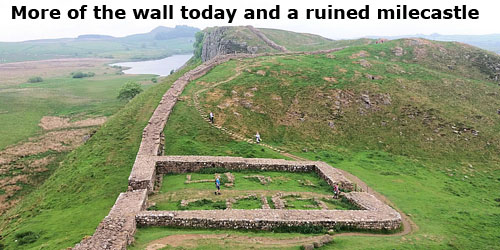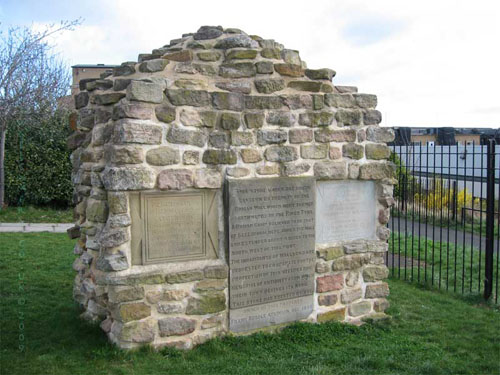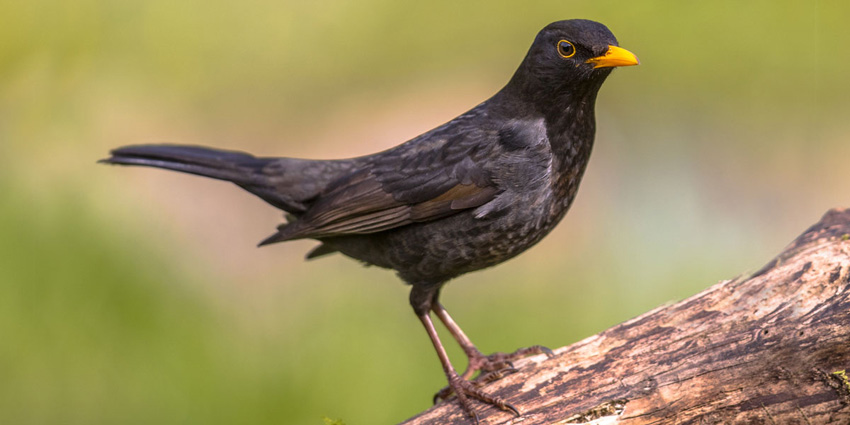




Back to the Tyne and Wear Page

- The Royal Connection
- Tyne and Wear Eats
- Owlbut's Birdwatch
- Tyne and Wear VIPs
 I will admit that I am slightly
stretching the "royal" connection here. The Romans didn't have Kings or Queens, they had Emperors. One such Emperors was a man called Hadrian who became Emperor
in 117AD. Five years later he visited Britannia as Britain was called. There had been a few minor rebellions and also the Picts who lived in what is now Scotland
kept coming down and raiding Roman Britain.
I will admit that I am slightly
stretching the "royal" connection here. The Romans didn't have Kings or Queens, they had Emperors. One such Emperors was a man called Hadrian who became Emperor
in 117AD. Five years later he visited Britannia as Britain was called. There had been a few minor rebellions and also the Picts who lived in what is now Scotland
kept coming down and raiding Roman Britain.
Hadrian decided to build a wall right across the top of England. Logically this became known as Hadrian's Wall.
It ran from the banks of the River Tyne, near the North Sea, to the Solway Firth on the Irish Sea. It was 117.5 kms (73 miles) long and between 3 and 6 metres
(10 and 20 foot) high. There was a milecastle (a small fort) every mile (logical that) and a larger fort every five miles or so.
 At the eastern end of the wall, the Romans built a fort known as
Segedunum. It was built in 127AD and was a bit of an afterthought. Originally the wall ended at Pons Aelius about 4 miles west and now in the centre of Newcastle.
Pons Aelius means the Aelian Bridge and Hadrian's family name was Aelian, which explains that. You can see all that is left of the fort in the picture and it is in
a town called Wallsend and I don't need to tell you how it got its name.
At the eastern end of the wall, the Romans built a fort known as
Segedunum. It was built in 127AD and was a bit of an afterthought. Originally the wall ended at Pons Aelius about 4 miles west and now in the centre of Newcastle.
Pons Aelius means the Aelian Bridge and Hadrian's family name was Aelian, which explains that. You can see all that is left of the fort in the picture and it is in
a town called Wallsend and I don't need to tell you how it got its name.
A large part of the wall is still there and there is a path, called Hadrian's Wall Path, which you can follow. The wall is a UNESCO World Heritage Site.
Although it was built to separate Roman Britain from Scotland it is not the border we know today. In the west it is just one kilometre from the current border,
at Wallsend it is 109 kilometres south of the present border.
![]() Back to the top
Back to the top
Bacon Floddies are a traditional
breakfast in North East England, especially in Gateshead. They are simple to make, cheap to make but fill you up for the whole day. In simple terms a floddie
is a type of potato cake made from grated, not mashed, potatoes. The North East was part of the Industrial Revolution and men would be working in the mines,
in the docks and shipyards or building canals. A filling breakfast was vital for a hard days work. These floddies were also popular during the second world war
when rationing limited the variety of food you could buy.
Potato floddies would not contain bacon and could have jam spread on them for a sweet dish or mixed herbs to make a savoury one. Sometimes they were
called canal floodies as the navvies working the canals would make them and cook them on their shovels over an open fire.
![]() Back to the top
Back to the top
This is the blackbird. All blackbirds are obviously black. Wrong. Female blackbirds are brown while young blackbirds also
have some orange and cream in their feathers. Male blackbirds still have some brown and white in their feathers. They all have brown legs and a medium length beak
which is black, brown, orange and yellow. They can be seen almost everywhere in towns and the country and woodlands, grasslands and farmland. There are over 5
millions breeding pairs in the UK and, during winter, there could be as many as 15 million birds here. Difficult to miss I would guess.
They are about 25 cms in length, have a wingspan of 34 to 38 cms and can weigh between 80 and 100 grams. They eat insects and worms but also berries
and fruit. I think it's certain that you will have seen one. If not, look out your window.

Seven random people who were born in Tyne and Wear in the last 100 years:-
Me (William Richard Rowland - 17 July 1949 - 8.10am - Newcastle General Hospital, Westgate Road - Delivered by Mr Snaith assisted by Sister Hughes -
Address at time of birth 70 St George's Terrace, Jesmond - Cost of Birth just over 21 pounds - mother kept a note of everything), less significant, Ant McParlin (TV Entertainer), Declan Donnelly
TV Entertainer), Donna Air (Actress and TV Presenter, Gordon Matthew Thomas Sumner better known as Sting (Musician and Activist), Sarah Millican (Comedian) and
Jordan Henderson (Footballer).
![]() Back to the top
Back to the top

